
Venue: Xiang Hai Xuan of Nan Lian Garden,
60 Fung Tak Road, Diamond Hill, Kowloon
Exhibition Period: From 2 March 2019 until further notice
Co-organized by Chi Lin Nunnery and the Leisure and Cultural Services Department
Buddhist beads, also known as chanting beads, counter beads, Mala beads and mantra beads, are portable implements used to keep track of the number of repeated recitations of prayers or mantras.
In ancient India, the Brahmins used strings of beads to help them pray. Buddhist beads date back to approximately the middle of the second century, and they were also mentioned in the texts of the Mokugenji Sutra and Vajraśekhara Yoga Sutra. By the time of the Tang dynasty, the use of Buddhist beads had become very common in China.
The use of prayer beads flourished under Buddhism and it is now popular in China, Mongolia, Japan, Korea, Thailand etc., with both monastics and followers. Not only are they an integral implement used to count mantra recitations, but a symbol of faith and diligence. When used faithfully in practice, the Buddhist beads can rid us of unclean thoughts, cleanse the spirit, and reconnect us with our purest inner self.
A wide variety of materials are used for Buddhist beads, with the most common being the seven Buddhist treasures: gold, silver, glazed glass, coral, amber, conch, agate, crystal, pearl, soapberries and bodhi seeds. Whether they are made from mineral or organic material, they are filled with the purest energy and essence of nature, and over time, this can raise the vibration, frequency and energy level of the user.
Buddhist beads, being an integral implement of Buddhist practice, are also a highly aesthetic arts and crafts accessory. At the Chi Lin Nunnery we have collected Buddhist beads throughout the years, and at the same time, we have inherited, practiced, and actively encouraged the creative use of Chinese knots and tassels. Paired with intricate and stylish knots, these precious Buddhist beads become auspicious and noble—the epitome of Chinese elegance.
It is our sincere wish that this exhibition of Buddhist beads will bring awareness and an appreciation of truth, goodness, and beauty through these wonders of nature.

The medicinal use of pine nuts has long been recorded in the historical ''Compendium of Materia Medico”. Strands of beads made of pine nuts in shell were prized by the Imperial Court of the Qing dynasty. The homonym of pine nut "songzi" implies the meaning of posterity, and has auspicious connotations such as “many blessings and longevity”.
The shell of pine nut is thin and brittle, with curve surface and slippery. Carving it is extremely difficult. This precious strand comprises of 21 pine nut beads, finely carved with a smooth and polished patina.
The words “West Lake Liu Zhou” and “Binqu Winter day" are engraved on two of the beads. It is believed that this strand is being carved by “Ven. Liuzhou" of the "West Lake" in 1846.
Beholding this strand of Buddhist beads in prayer, may the Triple Gem be preserved, and the continuity of the good governance and prosperity for our nation.
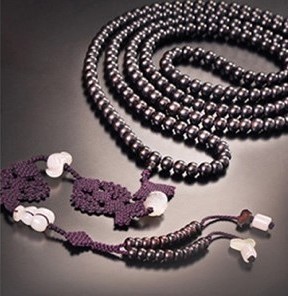
Yaizi seeds originate from India and have been extinct for over a hundred years. Known as the king of Buddhist beads, they are said to have the power to purify water. The rich lacquer black of the beads reveals a subtle red hue.
This precious string of 216 yaizi beads is accessorized with white nephrite jade ornaments in the shape of a water caltrop, a Buddha head and a gourd, all fastened with purple knots, and ending in two strands of ten beads with delicate jade carvings.
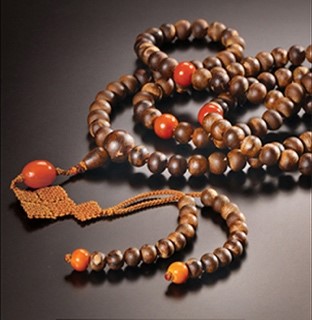
Kynam is the most precious grade of agarwood, with the highest concentration of aromatic resin and oil. Only one out of ten thousand agarwood trees may regenerate to form Kynam. Colors may range from white, green, yellow, purple, spotted, and black. Since Kynam is less compact than agarwood, so Kynam of supreme quality will not sink in water while agarwood does.
This strand of round kynam beads is enhanced with a selection of root amber beads, a kite-shaped knot, and ends with two strands of ten small kynam agarwood beads, each with a root amber bead ornament.
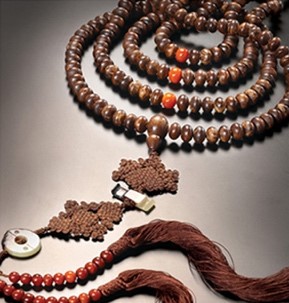
Agarwood is mainly found in the rainforests of South East Asia. When its trunk was hit by lightning or penetrated by insects, aromatic agarwood will be formed by the secretion of a dark aromatic resin, which is a byproduct of the tree’s natural healing mechanism. However, it takes several hundred years before the resin can transform to become top quality agarwood.
In Buddhism, agarwood has long been used in the offering to the Buddha and for meditation in early times.
This impressive strand of agarwood beads has three root amber separator beads, a pagoda bead, and two jade ornaments intertwined with intricate brown Chinese knots.

Sandalwood is a slow growing evergreen tree and it takes years to become mature for production. The texture of sandalwood is hard, yet fine and smooth. Generally, it is yellow-brown in color and can be found mainly in India, Indonesia and Australia. Being an ancient and rare tree species, sandalwood is reputed to have a divine calming and meditative effect. Its refreshing scent helps people to expel worldly desires and to be mindful. Therefore, sandalwood is highly respected and used by different religions.
This strand of oval India sandalwood beads has three oval root amber separator beads and complex Chinese knots in red.
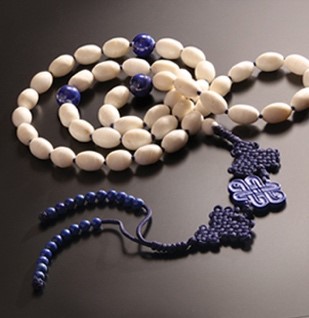
The composition of tridacninae, pearl and mother of pearl are quite similar, comprising of calcium carbonate and chitin. A slow build-up of multiple layers, the shell can be rather thick and when polished, which then becomes a semi-precious stone, is ideal for creating prayer beads and accessories. Colours vary; some are exceptionally white and prized for their purity.
This display of oval tridacninae beads has three lapis lazuli separator beads, a carved lapis endless knot ornament, and navy blue auspicious knots.
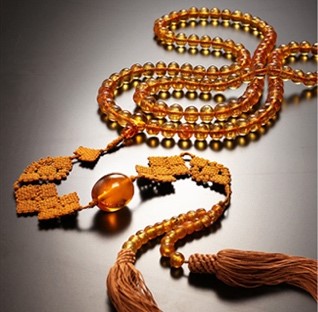
Lightest of all of the precious gems, amber is known to foster a sense of serenity, and has a calming effect on the wearer. The constituent elements of amber include carbon, hydrogen and a small amount of sulfur. The texture of amber is crunchy, astringent and can be crushed into powder. When amber is being burnt or rubbed hard, it gives a rosin smell.
"Golden silk” amber is formed by centuries of oxidation and exposure to light, resulting in a brilliant and warm glow. Strung and accessorized with orange-yellow knots and a large amber bead, this strand of amber is both noble and auspicious.
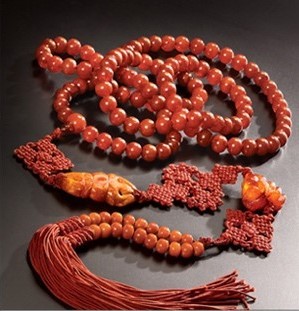
Root amber and amber are one of the seven treasures of Buddhism. Root amber is opaque while amber is translucent.
This magnificent and elegant strand of antique root amber beads has a pagoda bead, various auspicious orange knots, and two root amber carvings.
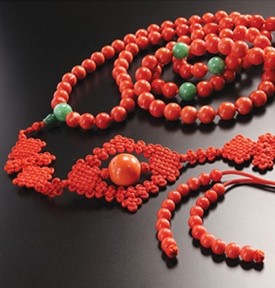
Coral is an organic matter and its main component is calcium carbonate. The colour of coral, formed during the calcification process, varies depending on the elements absorbed. Coral is considered to be one of the seven treasures by Buddhism. Red coral takes approximately 300 years before reaching maturity. Generally, it is believed that the Italians are the earliest miner of deep-sea corals since two thousand years ago.
This strand of Italian deep-sea orange coral beads has three green jadeite separator beads, a jadeite pagoda bead, a large coral bead, and orange knots in a pair of auspicious bat motifs.

Rock crystal, or colourless crystal, is considered the king of the crystal family. The main component in crystal is silica, with a relative hardness of 7 and a density of 2.6. It is often used as a purification stone for other crystals.
The purity and clarity of this exquisite strand of oval rock crystal beads is complemented with a crystal disc and auspicious taupe-coloured knots.
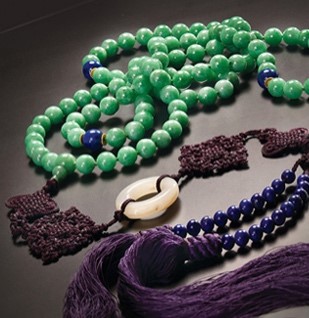
Jadeite is a pyroxene mineral, a metamorphic rock formed under low temperature and high pressure. Gem quality jadeite contains more than 50% sodium aluminum silicate. Colours range from white, green, violet, red, and yellow to black. A piece of good quality jadeite should be pure in color with 70 to 80 percent of it being green. It should look bright and have the color evenly distributed.
This strand of large round green jadeite beads has three lapis lazuli separator beads, a green jadeite pagoda bead, deep purple auspicious knots, a white jadeite disc, and ends with two strands of ten small lapis beads with tassels.
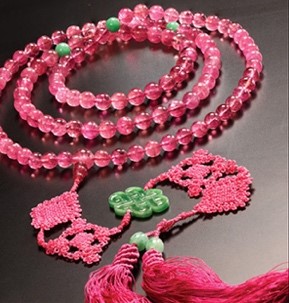
Translucency and clarity are highly prized in tourmaline. Since magenta pink tourmaline contains manganese, so it has a reddish-pink color. Red tourmaline may be brown, reddish-brown or even dark red in color and the most desirable ones are pink, fuchsia and rose.
This strand of magenta pink tourmaline beads is beautifully presented with three green jadeite separator beads, matching pink colour knots, and a carved jadeite ornament.
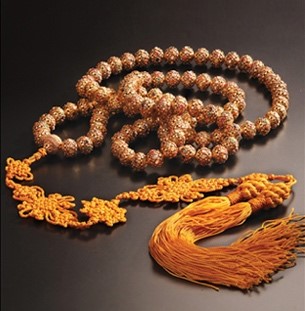
Gold is one of the seven Buddhist treasures, a substance which is pure, flawless and indestructible.
This strand of round gold beads is inlaid with various gems; the fine workmanship is exquisite and impeccable. It is complemented by highly intricate golden orange auspicious knots.
Mankind, the most evolved of living creatures, is gifted with dexterity and wisdom. We can learn about the skills, wisdom and committed dedication of our ancestors by studying the techniques used in the minor art form of Chinese knots. The understanding of their spirit and mindset will help to carry us from the past and lead us into the highly innovative and developed world of the future.
Chinese knots are complex and versatile with an unlimited permutation of lines, bends, arrangements, density and loops. The simplest design can be both ornamental and practical, and basic knots can be used on their own or collated and repeated into limitless possibilities.
The use of knots for Buddhist prayer beads not only performs the function of securing the beads but plays an important part in their decorative design. A string of precious prayer beads, when complemented with beautifully intricate knots, becomes uniquely exquisite. In this display of prayer beads, each exhibit is enhanced by expertly crafted knots, with detailed designs that convey auspicious, meaningful messages and blessings.
variation and composite knots.
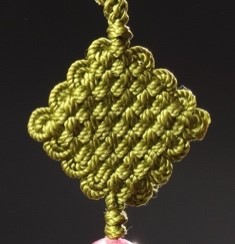 Flat Knot
Flat Knot
 Button Knot
Button Knot
combination of several knots.
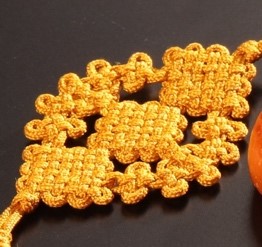 Modified Brocade Knot
Modified Brocade Knot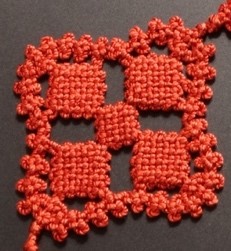 Revolved Diamond Knot
Revolved Diamond Knot 
For circulation at:
1. The Souvenir Shop of Chi Lin Nunnery
5 Chi Lin Drive, Diamond Hill, Kowloon
2. The Souvenir Shop of Nan Lian Garden
60 Fung Tak Road, Diamond Hill, Kowloon.
Co-organized by Chi Lin Nunnery and the Leisure and Cultural Services Department
Exhibition Period : From 2 March 2019 until further notice
Opening Hours : 10 am to 5pm daily
60 Fung Tak Road, Diamond Hill, Kowloon
Enquiry : 3658 9312
Website : http://en.chilin.org / http://en.chilin.org/tour/garden/index.html
Admission Fees:HK$20 per person (half price for the elderly, people with disabilities and full-time students)
Groups of 10 persons or more : HK$15 per person
Free admission on Wednesday (except for festivals or public holidays or when venue is hired or used for other purposes)
All proceeds will be used entirely as the funding for the management and operation of Nan Lian Garden.